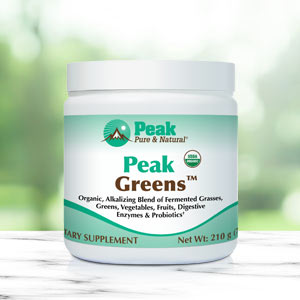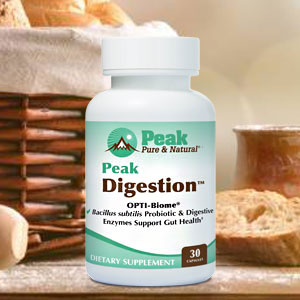Get Easy Health Digest™ in your inbox and don’t miss a thing when you subscribe today. Plus, get the free bonus report, Mother Nature’s Tips, Tricks and Remedies for Cholesterol, Blood Pressure & Blood Sugar as my way of saying welcome to the community!
Why GERD, acid reflux and indigestion increase in summer

If you think back to high school chemistry, you may remember learning about acids and bases, and pH levels.
To stay in good health, your body must constantly manage the delicate balance that keeps pH levels where they should be. The trouble is that some of our vital functions throw that balance off.
And summertime is when they can get really out of whack. In fact, 46 percent of Americans report suffering from heartburn symptoms most in the summertime and that it significantly impacts their ability to enjoy what most of us consider to be the most enjoyable season of the year.
If this sounds like you, here’s some insight into why and how to turn the summer of acid into the summer of fun…
Dehydration and pH imbalance
During the summer it’s not at all uncommon to experience some degree of dehydration.
Have you come inside after spending just a half hour or less watering your shrubs to find you’re a little dizzy or lightheaded?
Maybe several minutes later you begin to experience a mild headache, and then realize you’re feeling fatigued. Those are all signs of mild dehydration.
Your body is signaling that you need to replenish important electrolytes such as sodium, potassium, magnesium and calcium.
But replenishing those electrolytes does more than help your body use the water you drink to rehydrate. They balance your body’s acid/base (pH) level. Dehydration causes electrolyte imbalances that result in a more acidic blood pH, the last thing you need.
Hydration and pH are powerful allies against aging and acidity. Water helps maintain pH levels, which in turn aids all bodily functions — including how your body deals with temporary bouts of excess acid when you experience GERD, acid reflux, acid indigestion — but so much more. I’ll explain more about that below…
Acidic summer foods
Summer is when some of our favorite — and, unfortunately, acidic — foods are plentiful.
Take tomatoes for example. I eat more than my fair share of fresh tomatoes in salads (along with acidic onions) — and, of course, my ultimate guilty favorite, tomato sandwiches slathered in mayo.
But we’re also eating hot dogs and barbecued meats (with acidic and sugary sauces and condiments) more often — and downing them a crisp cold brew or one of those citrusy alcoholic drinks, complete with a tiny umbrella.
Aside from the acidity of the meat and sauces, alcohol has detrimental effects on the acidity in your stomach and your body. But so does another summer favorite: soft drinks.
Every time you eat or drink anything other than water (which has a neutral pH), the pH level in your mouth drops (becomes more acidic). This causes minerals in your tooth enamel to seep out as your body tries to re-establish a balanced pH — and soft drinks are the worst. But with body-wide acidity, the same thing can occur — except then it is the bones that are losing precious minerals.
All of this adds up to more acid in the digestive tract that’s just waiting to splash back up to the esophagus with every bite or sip triggering acid reflux.
Acid indigestion, GERD and reflux are immediate signs of acid overload. But there are times your body doesn’t give you any obvious outward signs. That’s when your health faces even bigger threats…
Unseen signs and miscellaneous effects of acid overload
About 75 percent of Americans are chronically dehydrated. Many of us drink acidic, sugary soft drinks, sugary flavored waters and imitation juice drinks, that’ don’t provide the hydration we need.
These acidic drinks and the acidic animal protein-heavy American diet, and even medication (particularly antihistamines), compound this dehydration.
Lack of water — dehydration — creates thirst, fatigue, weakness, pain and loss of appetite and leads to a buildup of toxic acidity.
And that acidity sets off a slow process of decline. So let me explain how that impacts your pH levels…
Your pH (potential of hydrogen) is a reflection of your body’s balance between its alkaline and acidic state. That pH is measured on a logarithmic scale in which 7.0 is neutral. The lower the reading on the scale the more acidic the body is — and the higher the reading, above 7, the more alkaline the body.
When the body maintains a high pH you feel vibrant, at ease and well. However, when the environment of the body is acidic, with a low pH reading, inflammation, pain, disease, and other unhealthful issues arise.
For example, pH can affect the viscosity of blood and that impacts circulation. An acidic body can even lead to depression and obesity because of how the body is hampered in its ability to process nutrients, expel heavy metals and metabolize wastes.
The main point here is that we want our bodies to be in an alkaline state most of the time.
If the summer heat, foods and activities are causing the most obvious symptoms of acid overload to flare up — acid indigestion, reflux and GERD. Take heed. The effects on your body are likely to go much deeper.
You can work at turning things around by eating a diet composed mostly of alkaline-forming foods and by avoiding acid-forming foods as much as possible. Most green vegetables and fruits are alkaline — and most processed foods, packaged and fried foods, and those taken from their natural state are more acidic.
Editor’s note: Did you know that when you take your body from acid to alkaline you can boost your energy, lose weight, soothe digestion, avoid illness and achieve wellness? Click here to discover The Alkaline Secret to Ultimate Vitality and revive your life today!
Sources:
Regulating your body temperature during summer heat — Michigan State University
Can the Heat Make Heartburn Worse? — Houston Heartburn & Reflux Center
Effect of electrolyzed high-pH alkaline water on blood viscosity in healthy adults. — Jefferson Digital Commons














